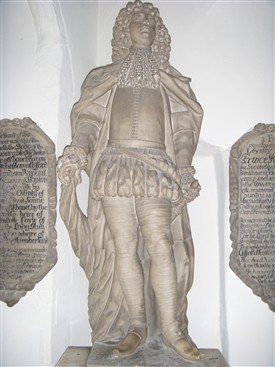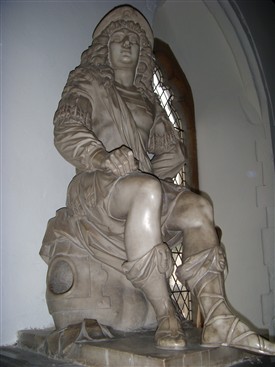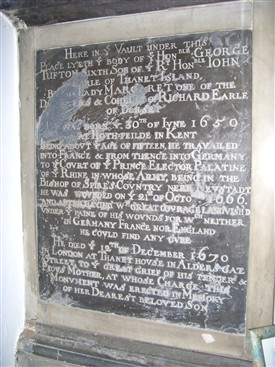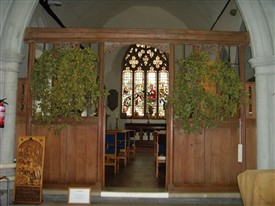Rainham Church - the burial place of the Lords Hothfield

Nicholas Tufton's statue at Rainham Church
Thanks to Rainham church

One of the two plaques next to Nicholas Tufton's statue
Earl of Thanet, Baron of Hothfield and Westmoreland, Lord of the Honour of Skipton ....

George Tufton's statue at Rainham

This plaque depicts George Tufton's short life
Well travelled and wounded at the age of 16, died aged 20

The Tufton Chapel at St.Margaret's Rainham
Hothfield and Rainham Churches are named after St.Margaret of Antioch
The Tufton Chapel in the Medway towns
By Chris Rogers, with thanks to Rainham Parish Church
The Rainham – Hothfield connection
If you go to Rainham, in the Medway Towns, you will find a Hothfield Road and a Tufton Road, but why? The past Earls of Thanet (later to be given the title Lord Hothfield) were wealthy land-owners and very influential people. In the 1600s the Earl of Thanet owned land in Rainham, Scotland, as well as Appleby (where the current Lord Hothfield now lives) and many other parts of the UK. At one time the Hothfield estate was one of the wealthiest in the country.
In Hothfield's church there is a large decorative tomb to a number of the Earl’s family, whose name was Tufton. Sadly the tomb used to get flooded and so the bodies were moved to Rainham church, and the tomb relocated to where it is now in a slightly higher position within the Hothfield Church (but it’s now empty).
It’s probably no coincidence that our church here at Hothfield and the church at Rainham are both named after St.Margaret of Antioch. Rainham’s church is bigger than ours but has a similar history, with much of the architecture coming from the same periods of time.
I’m very grateful to Rainham’s Churchwarden, Joyce, who in October 2011 took the time to show me around the church and in particular showed me the ‘Tufton Chapel’ where there are two life-size statues of two past Tuftons. Nicholas Tufton held several titles as well as being a Member of Parliament and Baron and Sherrif of Westinerland (Westmoreland). He is recorded as spending three and a half years in the Tower of London in connection with his loyalty to King Charles II, and died in November 1679.
The other statue is of George Tufton who was born in 1650 at Hothfield. The plaque on his statue records that he went to war across France and Germany at the age of 15 but within a year was severely injured in battle. He lingered for four years while being transported back across Germany and France where he died of his wounds at Thanet House in Aldergate Street, London. His body is one of those that is now in the vault below Rainham church and his statue was erected by his grief-stricken mother.
I was not allowed into the vault as the coffins were splitting open and there was a health risk, but I am grateful to St.Margaret’s of Rainham for taking time to show me the Hothfield connections. I would recommend a visit to their church if you are in the Rainham area.
One of the big land-owners in Rainham was the Bloor family who had waterfront land in ‘Lower Rainham’ including their own quay. The last Bloor to live there was Christopher Bloor who had no sons, but one of his daughters, Olympia, married John Tufton who therefore inherited the Bloor estate. Edward Hasted, in 1798, explains that former Earls of Thanet also owned other estates in the Rainham area before John Tufton married Olympia.
John’s son, Sir Nicholas Tufton, was the first Lord Hothfield and his statue represents one of the bodies in the vault below.
Bloor’s Place
The Bloor family lived in a Kentish Hall House built between 1470 and 1510. It is thought that this particular Hall House had a chimney, which was unusual for its time as most Halls had a fire in the middle of the floor and the smoke simply rose up through the roof.
As their wealth increased the Bloors demolished part of the original house and extended it. Further improvements and alterations have been undertaken in every century since, and the current building has been given Grade 2 Listed status. It also has a historic collection of outbuildings and garden walls which have their own separate Listing.
The Tufton’s wharf on the riverside was named ‘Blowers Key’ and the road opposite the grand house is still named Bloors Wharf Road today.